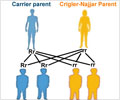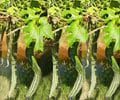Researchers at The Children’s Hospital of Philadelphia have suggested a simple test that can accurately identify which newborn babies are at risk for developing dangerous levels of jaundice.
Researchers at The Children’s Hospital of Philadelphia have suggested a simple test that can accurately identify which newborn babies are at risk for developing dangerous levels of jaundice.
Neonatal jaundice, skin yellowing caused by the build-up of the blood product bilirubin, usually goes away on its own, but in a small number of newborns it can progress to brain damage.The study recommends two options, used alone or in combination, to assess an infant’s risk of developing severe hyperbilirubinemia: a predischarge measurement of the bilirubin level and a screening checklist of risk factors such as intended method of feeding, siblings with history of jaundice, and race.
The study found that measuring the predischarge bilirubin in every baby and combining that information with the baby's gestational age accurately predicts which infants are at very high risk and which ones are at very low risk.
For the study, researchers studied outcomes for 823 newborns admitted to the Hospital of the University of Pennsylvania in Philadelphia between September 2004 and October 2005.
“The challenge facing every pediatrician who takes care of newborn babies is to identify those infants they send home that will develop a bilirubin level that could cause injury,” said Ron Keren, M.D., M.P.H., a pediatrician at Children’s Hospital and the lead author of the study.
“We found that by measuring the bilirubin in every baby, and combining that information with the baby’s gestational age, you could accurately predict which infants are at very high risk and which ones are at very low risk,” Keren added.
Advertisement
“It did a nice job of pulling out a very large group of babies you don’t have to worry about and a small group of babies that need to be closely followed,” Keren said.
Advertisement
“More research on risk-assessment strategies is needed to weigh the cost of implementing a universal program and its effectiveness for preventing severe hyperbilirubinemia against false test results, unnecessary testing and treatment, and delay in hospital discharge,” said Keren.
Their findings are published in the January 2008 issue of the journal Pediatrics.
Source-ANI
KAR/M











